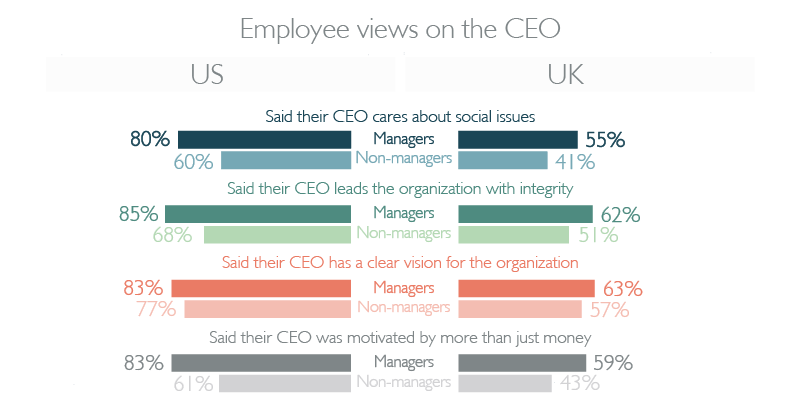The principle of workplace democracy has just got a whole lot closer
How do you make the most of your people? I am not sure Workplace Democracy would have sprung to mind until recently. However, when you look at this year’s events, be it the rapid shift towards home working, millions of employees suffering from furlough or employers burning through cash reserves that have taken years to build, old top-down business models, desks and creaking hierarchies are starting to look very 20th century. Instead, harnessing the power of the digital transformation revolution looks a lot more appealing, but are we really ready for a democratized workforce?
Using the exceptional global research from Unit 4 we look at why the idea of workplace democracy is challenging how leaders think and make decisions. What are the obstacles and opportunities that need to be tackled to achieve the workplace of the future? Looking at areas such as accessible CEOs and trust levels, are employees really ready for greater responsibility – and are managers really ready to hand it over to them?
The research
Unit 4’s research was based on interviews with 801 managers including the C-suite, VPs, directors, senior management and middle management. It also surveyed 1,036 non-managers in companies across the globe including Canada, Germany, the Netherlands, Norway, Sweden, the United Kingdom and the USA.
The CEO: leading the way or almost invisible?
The CEO is the figurehead: the one setting the culture, tone and overall direction of the company. And up to a point it looks like they are doing pretty well. They are regarded fairly favorably, with 68% of employees believing they have a clear vision for the organization, 67% saying they’re good at their jobs and 65% saying they’re trustworthy.
But it does still appear there’s room for improvement. Only 55% believe their CEO listens to them, and only 61% say their CEO is approachable.

This is something companies should think about. In any democracy, one of the essential elements is the visibility and accountability of the leaders. If they are distant, inaccessible and out of touch – or even if that’s the perception – the less likely it will be to feel like a democracy.
Just look at the positive persona of Apple’s Tim Cooke. He’s renowned for making himself accessible, and for setting the tone for what other leaders in the company should be doing too. As one employee explained, “The VPs and CEO are not removed either. It’s common to see them eating lunch on campus amongst everyone else.”
The same goes for Jack Salzwedel, chair and CEO of American Family Mutual Insurance Company. He’s highly regarded by employees, not simply for his Twitter presence, but for the level of genuine engagement he has with them as a result of it. It shows them he cares, it makes them feel like they matter and helps build a sense of greater democracy throughout the company.
Former CEO, now chair, of Booking.com Gillian Tans summarises the ethos perfectly. “Being accessible can seem daunting, but it’s critical to ensure your team stays engaged and motivated. It also allows you, as a leader, to be held accountable. It’s important to remember that your employees, of all titles and roles, are watching how you respond to situations and hearing the words you speak…both on a platform and in walking meetings through the hallways of your office.”
Do employees really have a voice?
The old school way of making decisions, the club sitting in the boardroom making the big calls, is increasingly out of step with the way workplaces of today (and certainly tomorrow) operate.
Knowledge and experience runs in all directions throughout a company. Not being able to capture the value from that means numerous opportunities are missed, yet this research suggests that might be what’s happening.

66% of managers feel fairly or very comfortable with expressing critical views about the operations or direction of their organization to more senior management. But only 10% of non-management employees feel the same way. The research tells us there’s a communications disconnect with half of workers feeling they have no say at all – which is perhaps not surprising given that around 2 out of 5 organizations rarely or never seek their views. Arguably the only thing worse than never asking for feedback is asking for it then doing nothing with it, yet this is something nearly 40% of companies did. It’s a wasted opportunity that could also risk increasing cynicism amongst employees.
It’s also worth noting the finding that men’s feedback is more regularly acted upon (28%) than women’s (13%): a possible indicator workplaces still need to do more to fully embrace a diversity of perspectives.
Do businesses have the right mindset to make the shift?
Workplace democracy relies on trust. It’s crucial for enabling greater responsibility to pass to non-managerial employees. To what extent do companies have the mindset where they can make that shift towards greater democracy?
There are some encouraging signs. 66% of managers agreed or strongly agreed non-management employees in their company understood the organization’s vision and direction. Just 10% disagreed or strongly disagreed with that. And 75% said they valued input on management decisions regardless of the level, gender or background of employees.
That’s positive but it’s not all good news. Trust in the abilities of non-managerial employees seems to be rather patchy. Less than half of managers fully or partially trusted non-management employees to make the right call even on the small day to day decisions. When it came to the longer-term decisions, it fell to 40%.

Some of this unease seems to be connected to a perception of business awareness; over a third (37%) of managers felt non-management employees didn’t understand the nuts and bolts of the strategy well enough. 28% were worried they’d make the wrong decision. More than a fifth thought their employees weren’t aware enough about the structure of the organization and or/the company vision.

Is this really a fair reflection of employees’ capabilities? Or does it tell us more about managerial confidence in their own ability to empower and delegate, or even misplaced perceptions that they will lose some ‘power’? It might be an indication that managers are trying to listen, but when it comes to making the final call, they need the reassurance of having the ultimate decision making power.
How much influence and input do employees have – and want?
How ready would employees feel to exert a greater influence and offer more input though?
There’s an even split between the number of respondents who’d feel uncomfortable approaching senior management to complain about something, with 37% agreeing / strongly agreeing they would do it versus 37% disagreeing or strongly disagreeing. There are similar numbers in terms of those believing employees at all levels can influence future direction: 35% agreeing versus 31% disagreeing. 42% of the non-managerial workforce thinks its voice is heard in the organization.

Dig a little deeper and it appears there are more nuanced factors affecting influence. 28% believe male employees have more or much more influence. 36% think employees with more than 2 years’ experience have greater influence. And 40% of respondents think employees over 40 have more influence. Despite efforts to increase diversity, it suggests older males with a few years’ experience behind them continue to be better placed to be heard within their organization.
There are mixed messages coming through the research, perhaps indicating pockets of positivity or negativity depending on the type of manager respondents have. There’s certainly more for organizations to do – but it’s encouraging to reflect that as employees become increasingly comfortable speaking out and sharing views, it’s likely to have a ripple effect across the company.
Meeting the challenge of increasing democracy
There’s a wealth of knowledge, experience and capability running throughout every organization – and it’s an enticing prospect that by finding ways to access it, companies can position themselves to improve productivity and performance.
There are challenges to be faced to make the workplace a more democratic place. Leadership needs to work on being accessible and transparent and set a clear ethos for the company in collaboration with its employees. Organizations need to work on trust, overcoming inertia and dealing with perception issues. They need to continue to focus efforts on building more collaborative, inclusive and supportive cultures, empowering employees and removing any fear managers have of being blamed if something their team does doesn’t work out. They need to encourage a positive work environment by embracing ideas from all parts of the organization and making sure efforts are recognised and thanked.
Read more: Reconciling organizational and personal values: dissecting the ILM’s latest research
As the report concludes, the tools are all there to make it happen. With the right mindset combined with technology as an enabler, there’s a lot to be excited about right now.


 30 ideas to help a new starter in their first week
30 ideas to help a new starter in their first week
 The value of external feedback in the workplace
The value of external feedback in the workplace
 Expand the power of recognition with Partner Appreciation
Expand the power of recognition with Partner Appreciation